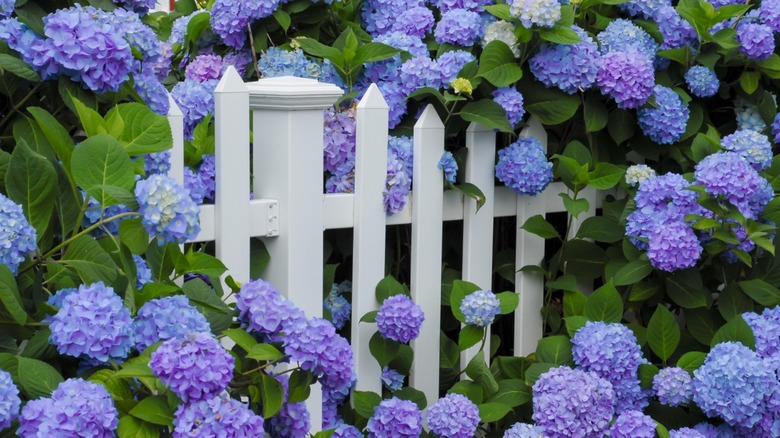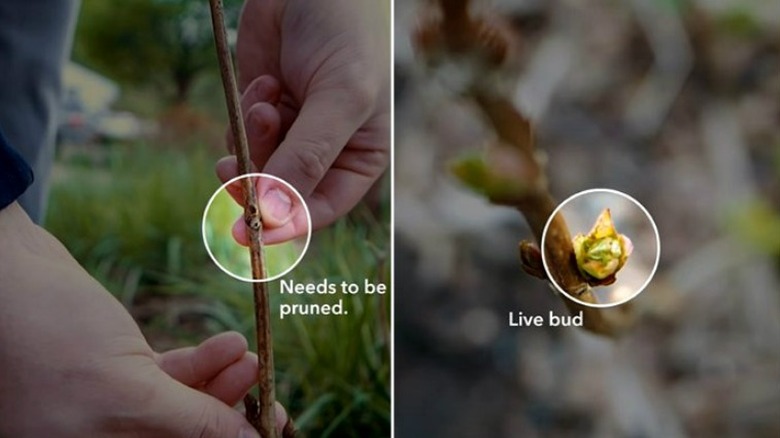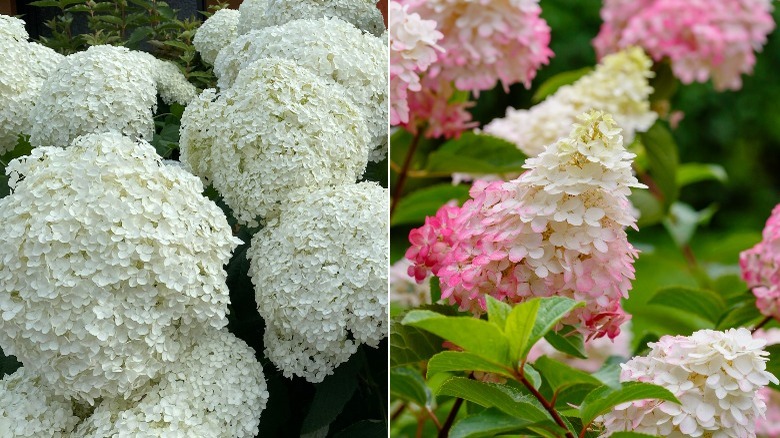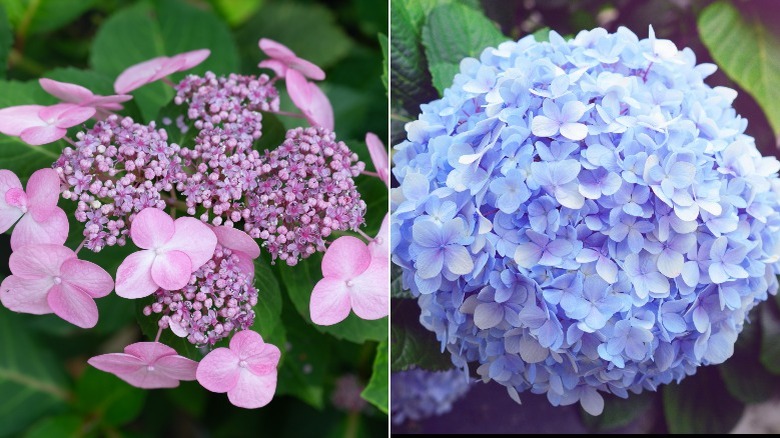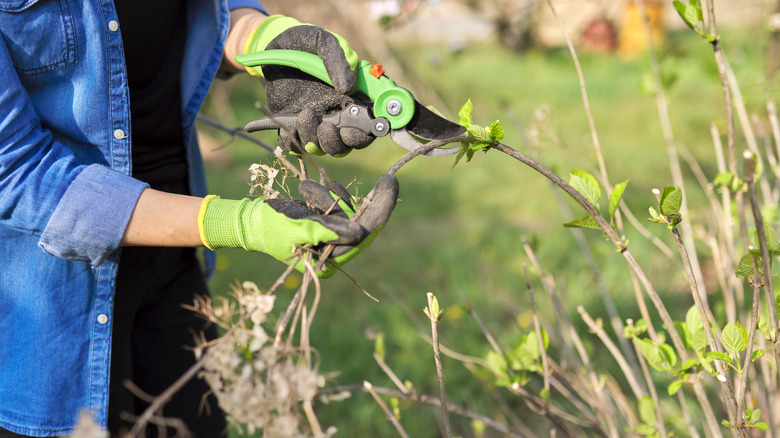How To Prune Hydrangeas
Hydrangeas have gorgeous masses of blooms in a wide range of colors, including vibrant blues and pinks, lavender, rose, white, and even lime green, which makes them very hard to resist. They look beautiful in bouquets both as fresh flowers and dried. Reader's Digest explains that an 18th-century botanist thought hydrangea blossoms resembled the shape of ancient water pitchers and named the plant by combining the Greek words "hydor" (water) and "angeion" (vessel). It's an appropriate name for a plant that needs 1-inch of water per week during normal weather, and 2 inches during hot, dry weather, reports University Of Connecticut.
Hydrangeas are deciduous, woody, ornamental shrubs or climbing plants that are fairly low maintenance and can live a long time. There are six different varieties of hydrangea that grow in North America, and they can be grown successfully in either your garden or a container. Knowing when to prune them is a key factor in keeping them blossoming, and you're about to become an insider!
Why prune a hydrangea?
There is a lot of confusion when it comes to pruning hydrangeas. According to Fine Gardening, people mistakenly think the shrub is dying because of its brown, stalk-like appearance in winter. They cut the plant back hoping to spur growth when in fact, they may actually be cutting off future buds. Then, when the shrub doesn't bloom, they think the shrub is dead. Hydrangeas are very hardy plants and will continue to bloom with or without pruning. Pruning can help shape a shrub to maintain the size you want, and to remove actual dead growth, so the plant can focus its energy on new foliage, per the Virginia State University.
A sharp, bypass pruner is the best tool for making a nice clean cut across the woody stems of hydrangeas, recommends The Grounds Guys. If the thickness of a branch is over 3/8-inch, they suggest you use a bypass lopper. If it's over 2 inches thick, use a pull-stroke pruning saw. To avoid spreading diseases between plants, clean the pruning blades with Isopropyl Alcohol.
Before beginning to prune your hydrangea you need to identify whether it blooms on old wood or new wood, as this Gardener's Oasis blog describes. It is also important to know how to tell when it's the right time to prune your hydrangeas and where to make the cuts.
When to prune new wood hydrangea blossoms
Blooming on new wood means that the flower buds form on the stems that have just grown this year. As a result, they take longer to bloom since they have to first put out new growth. Hydrangea arborescens "Annabelle" (pictured on the left), and hydrangea paniculata "PeeGee" (pictured on the right) are two types of hydrangeas that blossom on new wood. They can be pruned in the fall, winter, or early spring, according to University Of Connecticut, however, if you prune them in the early summer you would snip off any potential flower buds for the current season.
Interestingly, the hydrangea paniculata, with its cone-shaped blossom, is the only type that can be pruned into a tree by removing its lower branches from the trunk. It doesn't need annual pruning except to trim out crisscrossed branches or dead wood. Hydrangea arborescens are sometimes cut down to within a few inches of the ground each fall or winter. Doing this can create beautiful hedges, however, the new growth may not be strong enough to support the huge, blossom heads. Alternatively, prune back to 18 to 24 inches tall and allow the older stems to increase in diameter from year to year.
When to prune old wood hydrangea blossoms
Some hydrangea blossoms grow on the old wood, meaning next season's flower buds start to grow the year before on last year's stems. This includes all varieties of the hydrangea macrophylla, also known as "big leaf" hydrangea, the French hydrangea, or the hortensia, per the Gardner's Oasis blog. These "big leaf" shrubs have two flowering varieties that either produce large, round mophead blooms (pictured on the right) or flatter, lace-cap blooms (pictured on the left). Other hydrangeas which blossom on old wood are hydrangea quercifolia "oakleaf," serrata or "mountain hydrangea," and petiolaris "climbing hydrangea."
The big leaf, oakleaf, and mountain varieties should be pruned in July as the blooms start to fade, but before September when flower buds are set for next year. Do not prune in the fall, winter, or early spring or you'll be removing next year's buds. When the hydrangea quercifolia "oakleaf" shrub is about five years old, University Of Connecticut recommends that you remove about ⅓ of the stems down to the ground each summer after blooming to revitalize the plant.
Some hydrangeas are exceptions
While most hydrangeas are shrubs, there is one type that is actually a vine. The hydrangea petiolaris has a slow growth start and can take up to five years before you see any blossoms. Don't prune it in the first two to three years as it establishes itself. After that, you can prune it in the summer right after the bloom period (or if the shoots are growing beyond the desired area) and since it is a vine, you can train it to grow onto a trellis or fence, says Gardener's World. These types of hydrangeas develop self-clinging tendrils after one season, meaning that over the course of 10 to 15 years if left unpruned, this vine can scramble up a tree and reach 30 to 50 feet high.
Another exception when it comes to pruning is the new cultivated varieties of reblooming hydrangea macrophylla, which blossom twice in one season. In the spring, wait until you see green buds on the old stems. Don't prune these as they will eventually become blossoms. If you see dried, brown buds on any stem, you can cut it at a 45-degree angle right above the last green bud. The new green, leafy growth that you see at the very base of the hydrangea will develop into stems and flowers later in the summer for a second bloom, giving you a garden full of color for several months!
